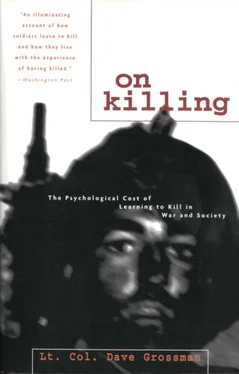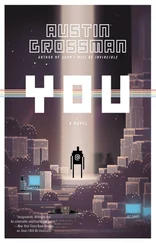It may indeed be necessary to engage in a war, but we must begin to understand the potential long-term price of such endeavors.
The Legacy and the Lesson
Man did not weave the web of life: he is merely a strand in it. Whatever he does to the web he does to himself.
— Ted Perry (Writing as “Chief Seattle”)
We may have enhanced the killing ability of the average soldier through training (that is, conditioning), but at what price? The ultimate cost of our body counts in Vietnam has been, and continues to be, much more than dollars and lives. We can, and have, conditioned soldiers to kill — they are eager and willing and trust our judgment. But in doing so we have not made them capable of handling the moral and social burdens of these acts, and we have a moral responsibility to consider the long-term effects of our commands. Moral direction and philosophical guidance, based on a firm understanding of the processes involved, must come with the combat training and deployment of our soldiers.
At the national strategic level, a recognition of the potential social cost of modern warfare has been obtained at a terrible price, and a form of moral and philosophical guidance gained from this experience can be found in the Weinberger doctrine — named after Caspar Weinberger, secretary of defense for President Reagan. This doctrine represents an initial attempt to form the kind of moral direction and philosophical guidance that can be built upon the lessons of Vietnam. The Weinberger doctrine states that:
• “The United States should not commit forces to combat unless our vital interests are at stake.”
• “We must commit them in sufficient numbers and with sufficient support to win.”
• “We must have clearly defined political and military objectives.”
• “We must never again commit forces to a war we do not intend to win.”
• “Before the United States commits forces abroad, the U.S. government should have some reasonable assurance of the support of the American people and their elected representatives in the Congress…. U.S. troops cannot be asked to fight a battle with the Congress at home while attempting to win a war overseas. Nor will the American people sit by and watch U.S. troops committed as expendable pawns on some grand diplomatic chessboard.”
• “Finally, the commitment of U.S. troops should be as a last resort.”
A Quest for Further Understanding
The Weinberger doctrine represents, in part, the recognition that a nation that sends men out to kill must understand the price that it may have to ultimately pay for these seemingly isolated deeds in distant lands. If this doctrine and the spirit in which it is intended prevails, it may prevent a recurrence of the Vietnam experience.
But this is just the beginning of a basis for understanding the potentially devastating social costs of modern war at other levels. Commanders, families, and society need to understand the soldier’s desperate need for recognition and acceptance, his vulnerability, and his desperate need to be constantly reassured that what he (or she) did was right and necessary, and the terrible social costs of failing to provide for these needs with the traditional acts of affirmation and acceptance. It is to our national shame that it has taken us almost twenty years to recognize and fulfill these needs with the Vietnam War Memorial and the veterans’ parades that have allowed our veterans to “wipe a little spit off their hearts.”
The military also must understand the need for unit integrity during and after combat. We are beginning to do so with the army’s new personnel system (which assigns and replaces whole units instead of single individuals in combat), and we must continue to do so; and like the British, who took their soldiers home from the Falklands by long, slow sea voyage, we must understand the need for cooldown periods, parades, and unit integrity during the vulnerable period of returning from war. During the 1991 Gulf War it appears that we generally got these things right, but we must make sure that we always do so in the future.
The psychological, psychiatric, medical, counseling, and social work communities must understand the impact of combat kills on the soldier and must attempt to further understand and reinforce the rationalization and acceptance process outlined in this book. In their 1988 research on PTSD Stellman and Stellman, both chemists by training, were the first to conduct a large-scale correlation study on the relationship between combat experience and PTSD. They reported that the “great majority” of veterans turning to mental-health services were not asked about their combat experiences, let alone their personal kills.
Last, we must attempt to understand the basic act of killing, not just in war, but throughout our society.
“Who the f*** are the two guys up here with the machine gun?” I asked, slinking back over the edge of the cliff.
“That’s gotta be Charlie, you asshole… Blow their ass up and run….”
They didn’t know I existed. Low underbrush shielded the edge of the cliff from their view, but I sure as hell saw them. My body started to shake and spasm as I rested my elbow on the hard laterite. I sighted down the barrel and put the front sight under one guy’s chest. He was sitting closest to the machine gun, and he would die because of it.
This is one f***ed up way to die, I thought as I squeezed softly on the trigger.
The explosion of the round roared like a cannon in my ear. My target flattened out, and for an instant I couldn’t tell if he ducked or had been hit. The doubts disappeared when I saw his foot quiver and his body shudder before he died.
I was so transfixed by his death throes that I never fired a shot at the other guy, who escaped into the thick brush to the south. I jumped over the cliff and ran to reach the dying man, not sure if I wanted to help him or finish him. Something made me have to see him, what he looked like, how he died.
I knelt beside him as his life leaked into the dusty earth. My one shot had hit him in the left chest and ripped through his back. The rest of the patrol was scrambling up the cliff and shouting, but the only sound I heard was the soft bubbling of the dead man’s blood as it soaked into the dirt. His eyes were open, and his face was still young. He looked terribly peaceful. His war was over and mine had just begun.
The steady stream of blood from his wound made a widening circle of darkness beneath him, and I felt my innocence deserting me as his life deserted him. I’d come all the way to Vietnam now. I didn’t know if I’d ever get out. I still don’t.
As the rest of the platoon reached the plateau, I found a bush on the flank of the campfire and retched violently.
— Steve Banko “Green Grunt Finds Innocence Lost”
Looking back on this narrative from the perspective of this point in the book, I find that there are many factors to be considered. Our newfound science of killology permits us to identify such key processes as the need to be ordered to kill (demands of authority and diffusion of responsibility), the picking out of the enemy soldier who was closest to the machine gun (target attractiveness and assisting in the rationalization process by picking the greater potential threat of two individuals who represented no immediate threat), and the emotional response of violent revulsion to the act of killing.
But what sticks in my mind is the phrase: “I didn’t know if I’d ever get out. I still don’t.” Those words haunt me.
This is no Ramboesque machismo; this is the actual emotional response of a young American soldier to one of the most horrifying events of his life. As he writes this to a national forum of understanding and sympathetic Vietnam veterans, he and many like him can be free to say that they were sickened by killing — and their writing and its publication become a vital catharsis. I believe that as these veterans write such narratives, they do not mean to say that the war was wrong or that they regret what they did, but that they simply want to be understood.
Читать дальше







